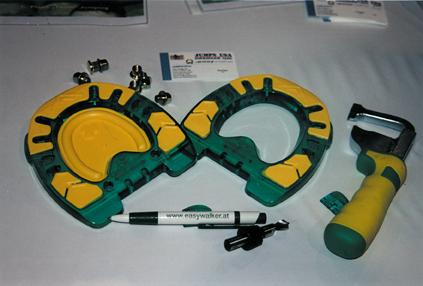Hey! Hope everyone has had a great holiday season, and good start to this New Year...
Now back to business. ;)
There was a time, not all that long ago, when horseshoeing in many parts meant pulling a plain shoe out of the keg, opening or closing it a bit, hooking the heels in, nailing the sucker on, and lopping-off whatever hung over the edge... If you wanted to get fancy about it, you could stick a sheet of leather or plastic between the shoe and hoof before nailing-on, or maybe even put the shoe on backwards for a 'bar shoe'...
Yes... The 'good old days' kinda' sucked.
The last quarter century has brought us to the opposite extreme. Some farriers pride themselves in turning out hand-forged horseshoes that are gorgeous works of art. Others love to use the latest modern products to assemble high-tech horseshoe packages worthy of Star Trek. A lot of guys do a bit of both.
Horseshoe fabrication skill is a wonderful thing. And many of the newer products and materials can be very useful in some situations. But I do think we sometimes have too much of a good thing. Especially in times like these, it may not be wise to go with fancy (and often expensive) alternatives just because we can. Especially when simpler approaches may work as well or better.
I was using glue-on shoes back when that meant riveting a rim pad jig-sawed out of a polyurethane sheet to an aluminum or steel shoe, then using a paint-stripper heat gun to weld tabs around the perimeter to be affixed to the sanded hoof with glorified crazy-glue.
Despite having the glue-on option in my arsenal, I've learned over the years that it is possible to securely affix shoes to some of the most disastrous looking hooves with good old-fashioned nails. Maybe having glue-on shoes handy has kept some of the newer guys from developing the particular skills it takes to hook solid nails through 'wishful thinking' hoof wall. But a lot of the hooves that prompt folks to say "there's no way you can nail a shoe to that" wouldn't even be a challenge to some of us graybeards.
On a related note, we have modern hoof repair products like Equilox and Equithane, which sure are an improvement over the auto body and wood filler putties we used to resort to. These newer adhesive/repair materials are often used to glue on shoes these days. But again, they are expensive, and can be a bit of a hassle to employ, especially in less than ideal field conditions. And sometimes they work too well... Sealing-in bacteria that turn into nasty infections. Deft nailing technique, and a willingness to let the foot be a little rough-looking until a damaged bit grows-out, often make hoof fillers unnecessary.
Like a lot of guys at the time, when I first started making bar shoes, I just used a keg shoe a couple sizes bigger than what the horse normally wore, turned the heels in 'til they overlapped, and forge-welded them together. Since keg shoe stock gets wider and thicker as you go up in sizes, this made for excessively heavy bar shoes. It also resulted in the nail holes being too coarse and too far back.
Then, late one Summer evening when I was wrapping up a long stretch of shop work, the wife came out to tell me that a mare I was supposed to reset the next week had lost one of her eggbars in the pasture where it was unlikely to be found. Since this mare would trash her thin-walled hoof if left shoeless any length of time, I knew I'd have to get to her the next day, despite the busy Summer schedule. But I certainly wouldn't have time to forge her a new pair of shoes in the field, and I was already worn-out for the day and didn't feel up to turning the shoes from stock that evening. So I just grabbed two pair of #1 St. Croix Rim Lites, cut the toes out of one pair, then turned 'em around and jump-welded them across the heels of another. Presto! Eggbars.
So, if the horse was happy, the owners were happy, and the job was a bit easier on me, why in the heck would I go back to using handmades? To impress other farriers? Heck, I don't work for them!
While all the fancy shoes and materials are great options to have, and can be literal life-savers in some cases, the most practical and effective shoeing solution for the widest array of corrective and therapeutic problems is actually a correctly fit, conventional horseshoe, properly applied to a well prepared hoof.









No comments:
Post a Comment